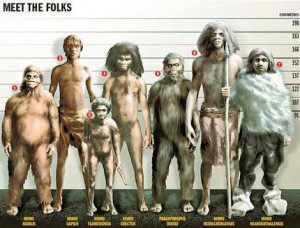 Sometimes science fiction looks backward instead of forward—some time travel stories, such as Ray Bradbury’s “A Sound of Thunder,” propel readers not into space, but back in time, so that characters can carouse with dinosaurs. Or, y’know, try to shoot them.
Sometimes science fiction looks backward instead of forward—some time travel stories, such as Ray Bradbury’s “A Sound of Thunder,” propel readers not into space, but back in time, so that characters can carouse with dinosaurs. Or, y’know, try to shoot them.
Michael Crichton’s Jurassic Park (a subject of an early Could This Happen? post) brought the past into the present, and achieved the unexpected feat of demoting the T-Rex to the second-scariest dinosaur around.
Of course, it’s not just the dinosaurs and the woolly mammoths that give the past intrigue that rivals the future—it’s the people. Er, the humans. I mean, hominids.
In the Neanderthal Parallax, Hugo Award winning author Robert Sawyer invents a parallel world in which Neanderthals develop the sentience of today’s Homo sapiens and become the dominant species.
Of course, this couldn’t happen—at least, not on this planet. Sure, there’s a service offering to clone deceased, beloved pets (there’s also a show about these pet owners on TLC in which “The Return of Sir Lancelot” takes on a whole new meaning). And just because we’re working on cloning the woolly mammoth doesn’t mean we could, or would, ever try to clone a proto-human, right?
According to Harvard geneticist George Church, cloning a Neanderthal isn’t just possible, it’s desirable.
Before we get going on this, let me point out that Church (the irony of his name alone makes this story a keeper) is a synthetic biology expert at Harvard. You’ve heard of that place. He played an instrumental role in developing the Human Genome Project, among other totally legitimate and awesome scientific project. So the guy has some credibility.
In an interview with German magazine Der Spiegel, Church promotes “de-extinction.” Sounds good in theory, right? I’ve always wanted to see a Do-do bird or a Quagga (which, by the way, a group of scientists in South Africa are trying to bring back). Church argues that since we can clone animals, why not humans? There’s a little thing called the law, his German interviewer points out. I guess cloning humans is illegal in Germany—score another point for those outlandish Teutons. While he acknowledges that this may be a problem, Church focuses primarily on technological possibility; he also sees a social mandate as more important than the law.
The interviewer asks what I see as the most pertinent question in all this: would one want to create a Neanderthal in the first place?
Church argues that because they’re an entirely different species, Neanderthals could provide clues about cognition, problem-solving, and brain development—they might even turn out to be more intelligent than humans in some ways. They could also provide some important clues about how diseases and antibodies develop. One of the primary goals of cloning a Neanderthal would be diversity. Church argues that monocultures are at great risk, and that breeding Neanderthals might help ensure humanity’s future.
Understandably, the interviewer is curious about how this would all work. Would the Neanderthals live in a lab under observation the whole time?
Church then waxes optimistic about creating a whole “cohort” of Neanderthals so they can establish an identity. He then talks about them becoming culturally and politically active. Well, we’ve had a black president. We’ll probably have a female president at some point fairly soon. How long until we have a Neanderthal in charge?
Although a recent discovery of a hominid skeleton in Serbia suggests that Neanderthals coexisted with humans—perhaps even a new species of human—and recent findings theorize that early Homo sapiens interbred with Neanderthals, I can see the anti-discrimination legislation and equal rights movement now…
Technically, cloning a Neanderthal wouldn’t be all that different than cloning a woolly mammoth. Scientists have sequenced the Neanderthal gene already. The next step, according to Church, is to divide the genome into thousands of chunks, and then introduce each synthesized chunk into a human stem cell. Given enough time and repetition, scientists could assemble a complete Neanderthal stem cell line which could be inserted into a human stem cell. Theoretically, this would produce a Neanderthal clone. It could also be possible to create a variation of the Neanderthal—a half-Neander, or a mutant-thal.
There’s just one small detail left! In order to bring this ambitious task to fruition, scientists would need “an extremely adventurous female human.”
Now, I would describe myself as adventurous. I’ve scuba dived–at night. I’ve sky dived. I’ve traveled to and within questionable countries by myself. I risk my life everyday bike commuting in Boston.
Whoever this female human might be, she’d have to be more than “extremely adventurous.” I think “batshit” insane is a bit more accurate; “fucking crazy” would also fit the bill.
Perhaps looking backward is looking forward after all. Sadly, Church says it’s unlikely that we’ll see the return of the caveman. Although now I know what I’ll do if I’m ever really in the mood for adventure.

